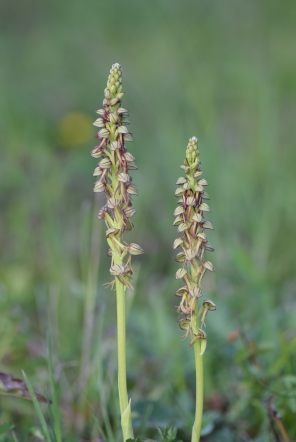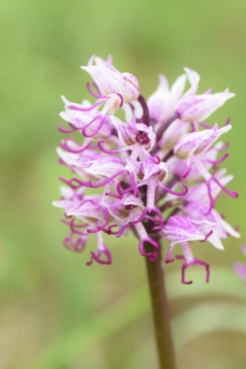Species Integrity and Gene Flow in Anthropomorphic Orchis species
I worked on a group of four orchids called man orchid (Orchis anthropophora), lady orchid (O. purpurea), military orchid (O. militaris), and monkey orchid (O. simia), found in England and across mainland Europe. They’re referred to as anthropomorphic because each one has flowers that look like little human figures – they’ve got arms and legs. At first glance, they look easily distinguishable (see below) and anyone could sit down with a very simple botanical key and be able to identify them all.
However, when these species grow together, they can’t keep their hands off each other and they reproduce with one another. These inter-species partnerships result in intermediate offspring called hybrids that look half like one of the parental orchid species, and half like the other, as if they have been merged together. Take the hybrid Orchis x angusticruris for example, the result of a coupling between a lady orchid and a monkey orchid. The flowers have a distinct halfway feel to them:
Where hybridization events such as this occur, it often leads to the build up of large populations of hybrid orchids. Some hybrids appear to be sterile, while preliminary data suggests others are able to reproduce with each other and with their parents, giving rise to a morphological and genetic spectrum. Very simply, you can imagine it like this: the two parent species are at either end and the hybrids occupy the space in between. Some will be perfect intermediates, some will look more like parent A and some will look more like parent B.
Here in the UK these orchids are generally rare. Military and monkey orchids can only be found in a handful of locations and both lady and man orchids, while commoner, have highly restricted distributions. As a result, hybridization between them has rarely been recorded, simply because they never occur in close proximity. There is one exception though: a hillside nature reserve called Hartslock in rural Oxfordshire, where hybridization is rampant between monkey and lady orchids. They are stunning plants, vivid pink and tall, full of teenage vigour. But the occurrence of lady orchids at the site is widely believed to be a result of human activity, so there is a debate about whether or not the hybrids should be protected as there is a chance they could have a negative impact on the monkey orchid population. If the hybrids are fertile then they could reproduce with the monkey orchids, diluting the native monkey gene pool with lady orchid DNA. However, to make things even more confusing, the population of monkey orchids actually contains DNA from military orchids, the result of a hybridization event in the past when these two species grew together in the Thames valley. So they aren’t technically ‘pure’ monkey orchids anyway. And the plants there are tiny, weak things, albeit still beautiful, which probably signifies a reduced gene pool, so actually these monkey orchids might benefit from an injection of healthy Orchis DNA from the ladies via the hybrids. To date there is no evidence of gene flow in this population, but it’s a really interesting case study.
In mainland Europe, however, they are all much commoner and can frequently be found growing together. I visited the south of France to collect data and was lucky enough to encounter all six possible hybrid combinations:
So my PhD was basically this: I tried (ha) to work out why these four orchids remain as separate species, rather than merging into one big hybrid super-species, despite the flow of genes and DNA sequences between them, via the hybrids.
As you can imagine there are lots of questions to be answered! I used new DNA sequencing techniques to tease apart relationships among these species and to characterize patterns of hybridization. You can read some of my research in a paper we published in 2021 – we hope this will lead to greater understanding of species coherence in this group, improved understanding of hybridization and better-informed conservation management.
Have a read of my blog on the Kew Science website: the secret sex life of anthropomorphic orchids
Videos about my PhD can be found on my YouTube channel
Some of our research is published in the American Journal of Botany – it’s open access so no pay wall, you can read it here













